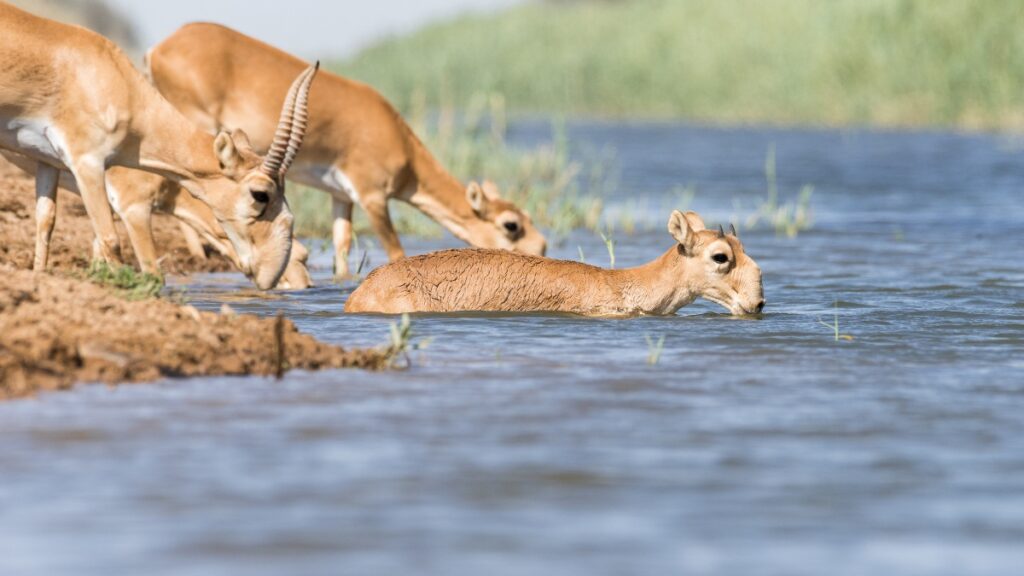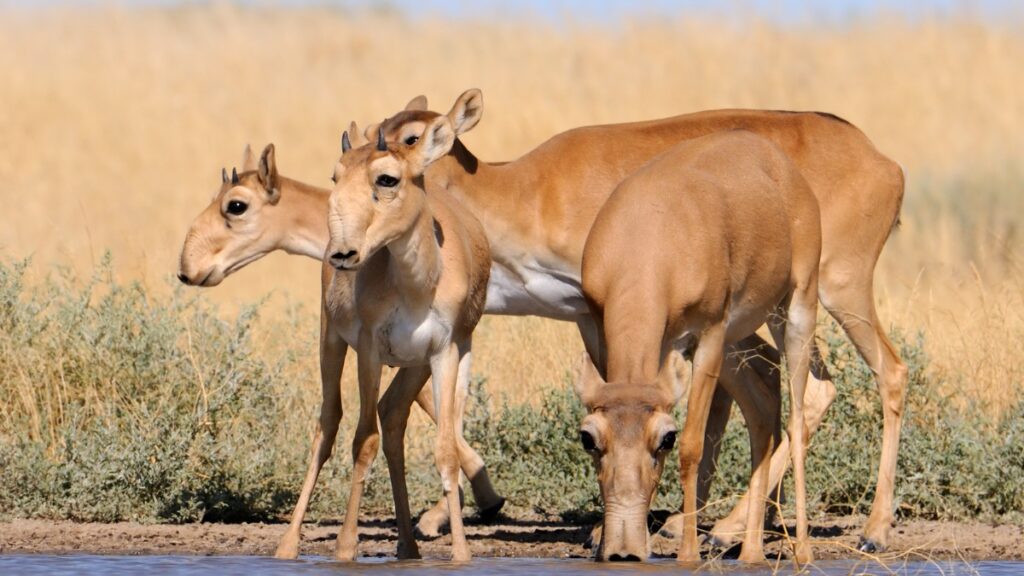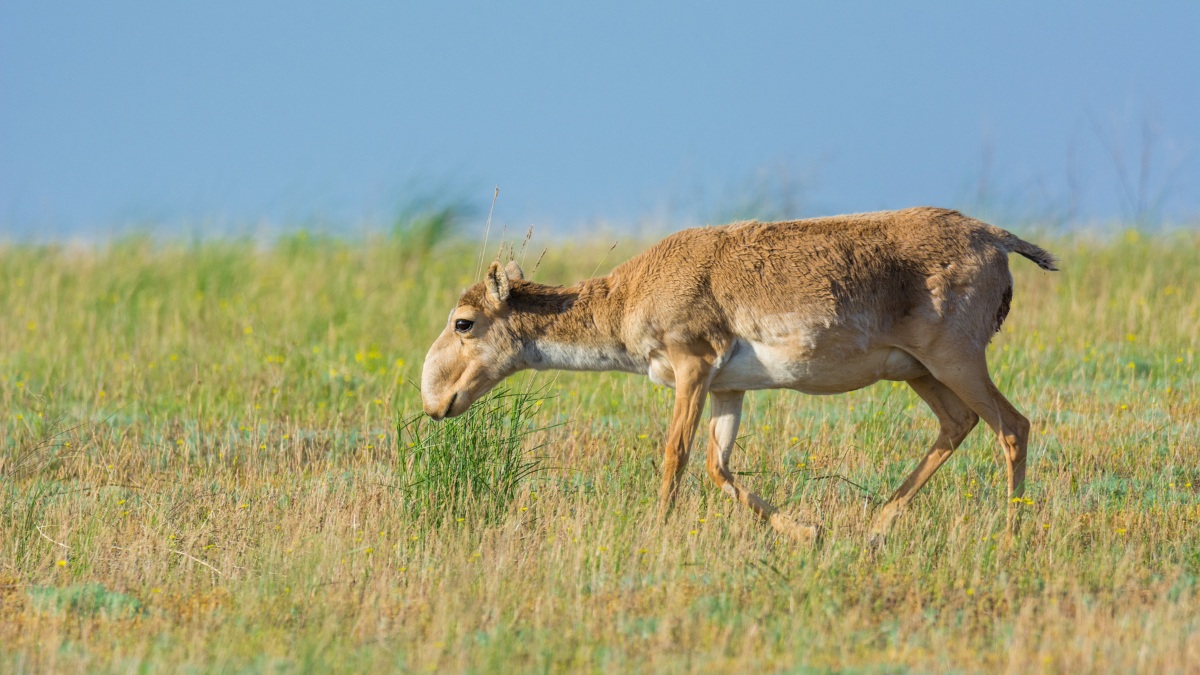Scientifically known as Saiga tatarica, the saiga antelope belongs to a fascinating and critically endangered species that has caught everyone’s attention in wildlife and conservation. Provided with a bulbous nose and adaptive behaviors, the saiga antelope is an unusual species in species that have evolved to thrive in the harsh environments of the Eurasian steppes. In this paper, we are going to discuss the behavior of the saiga antelope, focusing on their social structures, reproduction, movement, and the adaptations that allow them to live in those unfavourable conditions of their habitat.
Contents
Social Structure and Grouping
The Saiga antelope is a highly social species that lives in large herds, a habit typical for its survival. The numbers vary during the course of a year, but small groups of only 10-50 individuals of a very lush summer or high number aggregations of several thousand at the breeding and calving times.
Saigas assemble in massive numbers during springtime for their mating and calving time, which is characterized as highly social. After the calving season, the herds become fragmented due to the dispersion of females into groups to summer ranges. This type of herd structure ensures efficient protection and resource utilization, particularly when it comes to the detection of predators and availability of food resources because larger groups are better positioned.
Reproductive Behaviour
The reproductive behavior of the saiga antelope is complex and critically important to its survival. During the late fall mating season, males actively compete with each other to gain mating rights. The males exercise a series of behavioral events that separate dominance from consideration for the females, such as vocalizations, aggressive interactions, and their characteristic horns.
Female saigas assume the first position of importance in the reproductive cycle. Their activities are significantly dependent on the duty of calf protection. Females are very vigilant during the lactation period, and their vigilance activity varies with increasing age of calves. For instance, the time spent and number of times the female vigilates decline with an increase in maturity of the calves, indicating that the animals have less dependency on constantly guarding.
Also Read: Bees’ Waggle Dance: How They Communicate to Find Flowers
Migration Patterns

Saigas are known to migrate in long distances of over 1,000 kilometers between summer and winter habitats. This is mainly due to the avoidance of harsh weather conditions but also as a way of finding adequate food and water resources. The saigas usually cross rivers and traverse large steps of semi-deserts as they always avoid areas which seem to be steep or quite rugged in their course of migration.
Climatic changes also play a role in the migratory behavior of saigas. For example, extremely high and wet temperatures may induce mass mortality by some normally harmless bacteria causing fatal infections among over 200,000 saigas. This again points out the vulnerability of saigas to climate change and the vagaries of weather.
Feeding and Diet
Saiga antelopes are herbivorous animals, or graminivorous, feeding on a great array of grasses, steppe lichens, and other plants. These animals are remarkable because they can consume plants that most other animals find too poisonous, giving them food resources that most herbivores have no access to.
One of the major activities that saigas do is foraging, which occupies them more than half their day. The time budget of saigas differs according to the period, whether it is either mating or lactation season. Here, older individuals’ great portions of time are engaged in social interactions associated with mating, a factor important for the species’ reproductive success.
Communication and Vocalizations
Communication is important for saigas, especially during the breeding season. Saigas possess oral and nasal vocalization; these are individually recognizable to mothers and their calves. This personal vocal identity is important in maintaining the mother-offspring bonds in the large herds, especially in the cacophony of breeding and calving times.
The male’s special nasal calls serve as an attracting low-frequency signal to females. The big bulbous nose of saiga antelopes is a filter for sounds-a device enhancing the efficiency of calls in an extreme steppe environment.
Adaptation and Survival Tactics
The most characteristic adaptation of this species is the nostril, although of great profile. In its bulbous appendage, the saiga serves several functions: it acts as a dust filter during its summer migration, cools blood in hot weather, and acts as a radiator to warm the cold air before it enters the lungs in winter. Such an adaptation is decisive for survival in the severe oscillation of the Eurasian steppes.
Other than their nasal adaptation, the saigas undergo a seasonal coat change in order to adapt to the temperature change. In summer, they appear yellow or red while during winter they show a pale, grayish-brown color. Such a coat change, along with the thick fur kept during the winter season, helps them survive the hazardous winters and very hot summers of their habitat.
Behavior of Hiding and Vigilance

Female saigas use hiding type behavior to their calves, especially at birth. They tend to prefer hideouts in short shrubs areas than in high shrubs or trees. Such behavior is also influenced by the availability of disturbances from other saigas, especially adult males and human activity. The choice on routes while moving among hideouts is usually left in the hands of mothers and is made to ensure safekeeping of their calves.
Vigilance is another behavioral attribute of female saigas that greatly defines them, particularly in cases when they are lactating. The rate and time spent in vigilance change with the development of calves; it indicates that protective behaviors concerning them can be dynamic. It is illustrated by showing females with active juveniles, as well as those walking solo, are most vigilant, indicating an increase in awareness regarding possible threats.
Conservation Status and Threats
This animal is listed critically endangered in the IUCN Red List, mainly because of uncontrolled hunting of the species and the commercial demand of their horns for traditional Chinese medicine. These horns, or Cornu Antelopis, are valuable products and therefore illegal because of international bans on trading the horns with these species.
Most importantly, agriculture and human settlements have resulted in habitat loss and fragmentation. Climate change also is a looming threat that, over the short term, will primarily impact food resource availability and increase the chance of catastrophic mortality events from extreme climatic conditions.
Conclusion
The behavior of the saiga antelope: a very complex mixture of social interaction, reproductive strategies, migratory patterns, and adaptive behaviors that have been developed and honed over the millennia to ensure survival in one of the most hostile environments on Earth. Only through an understanding of such behavior can protection of this unique, critically endangered species be secured through conservation efforts.
The different kinds of threats that are against the saiga antelope-from poaching to habitat destruction and impact from climate change-are necessary steps in attempting to contribute to saving the antelope. Understanding better the behavior of the saiga will shape public opinion and management decisions so we might possibly save this majestic creature for yet unborn generations.
Also Read: Monarch Butterfly Migration: How Monarchs Travel Thousands of Miles
